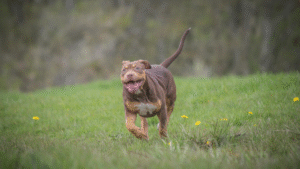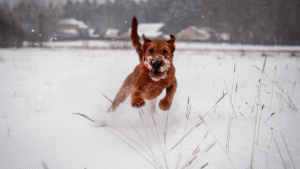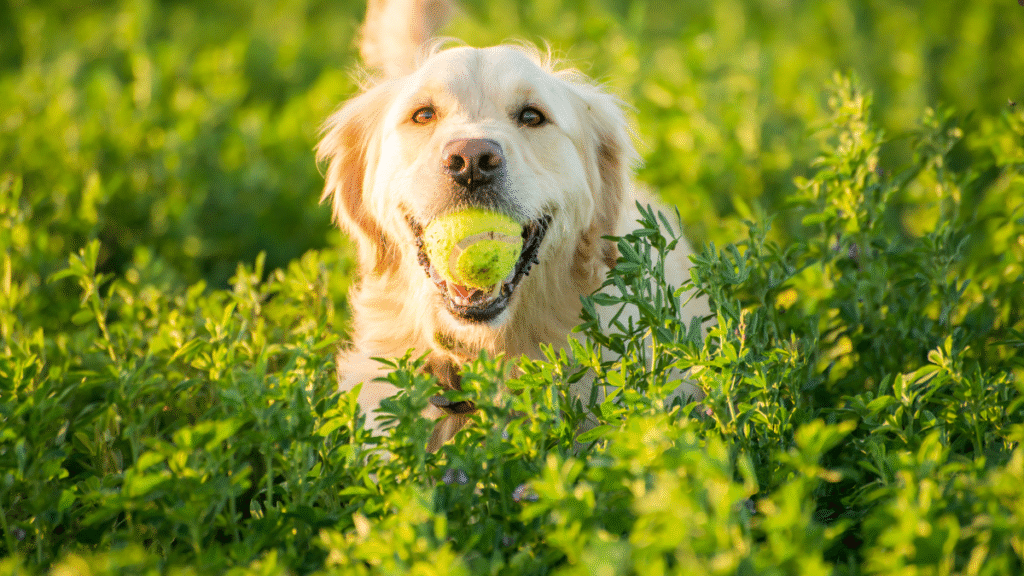Has your furry friend ever unleashed their inner monster at the most inopportune moment? You know what we’re talking about: that wave of crazy energy that comes out of nowhere when they hear the doorbell, see another dog, or just decide it’s playtime 24/7.
While a good game face is great, an overly excited dog can be a major buzzkill. It’s exhausting to manage, difficult to train, and can even lead to some embarrassing (or dangerous) accidents when your dog isn’t able to control themselves.
The solution? Calm training. Teaching an overexcited dog to settle down and self-regulate their emotions can transform your life.

Why Dogs Get Overly Excited
Let’s start with the basics: why do dogs even get overly excited? Excitement is an emotional response to stimuli that any healthy dog experiences from time to time. It’s not an issue until it gets in the way of your dog’s training, safety, or your quality of life at home.
Common Reasons Dogs Become Overexcited
Physical Energy
Dogs, especially young and high-energy breeds, need lots of exercise to avoid pent-up energy. Physical activity releases endorphins and helps dogs feel happy and calm.
Mental Stimulation
Just like humans, dogs need mental challenges. Boredom and lack of mental engagement can cause an excess of energy to come out in unproductive ways like barking or hyperactivity.
Inconsistent Boundaries
If you’re not consistent with your boundaries and expectations, your dog will never learn what’s acceptable. Allowing some jumping or barking sometimes while not allowing it other times creates mixed signals.
Excitement Gets Rewarded
An overly excited dog probably had their enthusiasm reinforced at some point. Maybe you petted them when they jumped up, or playfully scolded them, or gave them the toy they were so excited about. It’s how they learn.
Breed-Specific Traits
Working dogs and high-energy herding dogs like Border Collies, Aussies, and Labradors are famous for their energy. If that power isn’t channeled into productive training and exercise, it can easily go in other directions.
Related:7 Best Dogs For First Time Owners
Environmental Triggers
Dogs can become excited by a host of outside situations: visitors, other dogs, car rides, being let off leash, or a whole host of other stimuli. Learning to manage these triggers helps reduce overstimulation.
Recognizing Overexcitement In Dogs
Excitement is a normal emotion in dogs but becomes a behavior problem if it’s:
Hard for your dog to regulate themselves
Causes accidents or failure to respond to commands
Creates chaos around your house
Avoids training altogether
Worries you or guests
Signals in an Overexcited Dog
Jumping on people
Barking excessively
Spinning, running, or zoomies
Nibbling/mouthy behavior
Panting, pacing, or not settling down
Difficulty calming down after stimulation
Wait… Isn’t Excitement Good?
Excitement in dogs is not inherently bad! A happy dog is an excited dog. If your dog can self-soothe and listen to you when they’re overstimulated, it’s not a problem. The issue is when they’re unable to calm themselves or behave predictably around people and other dogs.
The Importance of Calm Behavior in Dogs
Teaching your dog calm behavior is not about squashing their personality or making them into a robot. It’s about helping your dog learn to modulate and appropriately self-regulate their emotions. Dogs don’t automatically know how to pause before reacting, so it’s up to us to teach them impulse control.
Benefits of a Calmer Dog
Dogs who can remain calm in a variety of situations are:
Easier to train
Safer around people, other animals, and in new situations
Less likely to suffer from anxiety or behavioral problems
More enjoyable to live with
So, how do you create a calmer dog? Let’s dig in.
Step 1: Adequate Exercise is Essential
Many dog behavior problems come down to energy levels. One of the first steps to calming your dog is to ensure they have an appropriate outlet for all their excess energy. A tired dog is a good dog!
Physical Exercise
Daily walks (at least 30–60 minutes or more depending on your dog’s breed and age)
Fetch or tug games to burn energy
Agility training or running, especially for high-energy breeds
Swimming (low-impact and excellent for joint health)
Mental Stimulation
Puzzle toys/treat-dispensing games
Scent work (hide treats around the house for them to sniff out)
Basic obedience exercises
Teaching your dog new tricks/games
Exercise should be a healthy balance of physical and mental stimulation to keep your dog’s body and brain happy.

Step 2: Stop Reinforcing Overexcitement
Excitement is a reward-based behavior. In other words, your dog will continue to be overexcited because they’ve learned it’s a great way to get attention. The way to stop overexcitement is to not give it any attention at all.
Tips To Stop Rewarding Excitement
Don’t acknowledge your dog if they’re jumping up or barking for attention
Wait until they are sitting or lying calmly before you give them any attention/treats/petting
Use a calm voice when greeting your dog
So, if you come home and your dog is jumping all over you, don’t immediately start petting and greeting your dog in a high, excited voice. Instead, wait patiently until your dog calms down, then shower them with praise.
Step 3: Teach the “Settle” or “Calm” Command
The “settle” or “calm” command is an important tool in calming down an overexcited dog. Training your dog to settle on cue lets you take back control during potentially overwhelming situations.
How to Teach Settle or Calm
Pick a quiet moment when your dog is calm and relaxed.
Say “settle” or “calm” and then reward your dog for lying down and staying in a sit/stay until they calm down.
Gradually increase the distractions around your dog while rewarding calm behavior.
Practice regularly, especially before activities that will be high energy/stimulating, like walks or guests coming over.
Over time, the “settle” or “calm” command becomes your magic cue when your dog starts to get overstimulated.
Step 4: Practice Impulse Control Games
Impulse control is the ability to hold back an immediate reaction. Dogs can learn impulse control just like humans can, and we can train them with structured games and rewards.

Impulse Control Exercises to Try
“Wait” command (before meals, door openings, etc.)
Have your dog sit and wait until you release them
“Leave it” or “drop it”
Teach your dog to leave a treat or toy alone until you give them permission
“Stay” or “place”
Train your dog to stay on a mat or bed until released
These exercises build patience and focus in your dog, which is key to managing overexcitement.
Step 5: Manage Triggers & Environmental Stimuli
Excitement in dogs often comes from predictable triggers or environmental stimuli. By managing and desensitizing your dog to these triggers, you can help them learn to stay calm when they used to be overexcited.
Example 1: Dog Gets Overexcited When Guests Arrive
Situation: Your dog jumps and barks wildly at guests.
Management Strategy
Have your dog on leash or behind a baby gate when guests arrive
Ask guests to ignore your dog completely until they are calm
Reward your dog with treats and attention for calm behavior
Over time, your dog will associate being calm with getting treats/guests attention.
Example 2: Dog Gets Overexcited on Walks
Situation: Your dog lunges and barks at other dogs or distractions when on leash.
Management Strategy
Increase the distance between your dog and the distractions
Practice focus commands like “look at me” to get their attention on you instead of the distraction
Reward your dog for paying attention to you, not the trigger
Repeat as needed
Slowly, your dog will learn to walk by other dogs calmly instead of overexcited.

Step 6: Provide a Calm Home Environment
Dogs take their emotional cues from their environment and the people around them. If you want a calm dog, it helps to live in a relatively low-energy, quiet household.
Tips for a Calm Environment at Home
Keep background noise low-key (low volume music vs. loud TV for example)
Avoid rough play or high-energy toys indoors
Provide a designated calm zone for your dog to go to when they want to relax (crate, bed, etc.)
Consider calming aids like:
Adaptil diffusers (release calming pheromones)
Weighted blankets or calming beds
Calming chew toys (exercise/release energy)
Step 7: Be Patient & Consistent
Consistency is key to any kind of dog training. If you want your dog to change their behavior, every person in the household needs to use the same rules and rewards.
Patience is also important. Don’t expect your dog to transform immediately. It will take time, repetition, and patience to see results.
Remember to praise small successes — like your dog calming down a few seconds sooner than before — and keep building on them.
Step 8: Know When To Ask For Help
If you’ve tried everything and your dog still can’t calm down or their excitement borders on uncontrollable, it may be time to get outside help.
Don’t feel bad asking for a professional trainer or behaviorist. A professional can offer support, a different perspective, and may be able to pinpoint any specific triggers that are causing the overexcitement.
Look for a positive reinforcement certified trainer (PDT or CPDT-KA). These trainers are certified by a professional body to ensure their methods are based on science and positive reward-based training.
Never use a trainer that uses punishment or dominance-based techniques.
It may also be worth speaking to your vet about your dog’s overexcitement to rule out underlying anxiety or medical conditions.
Everyday Tips to Encourage Calm Behavior in Dogs
Use low-key greetings. Quietly greet your dog instead of high-pitched squeals and jumping.
Limit use of high-energy toys and games. If your dog gets crazy over a squeaky toy, don’t use it as a training aid until they can use it more calmly.
Model calm behavior yourself. Dogs pick up on their owner’s emotions so be the chill energy you want to see in your dog.
Catch your dog being good. Randomly reward your dog if they’re being calm. If you see your dog calmly waiting, softly say “good” and toss them a treat.
Over time, your dog will start to make the connection between calm behavior and positive outcomes.
Final Thoughts
An overly excited dog isn’t “bad” or abnormal — they’re just bursting with life, energy, and excitement. The trick is finding ways to balance out their energy and help them self-regulate.
Regular exercise, consistent rules and boundaries, patience, and calm leadership will make a huge difference. Your dog will still be just as happy and energetic — but more relaxed, obedient, and pleasant to be around.
Remember: all dogs are capable of calmness, it just takes time, patience, and the right training to help them get there.
- 5 Cheap Alternatives To Dog Training Equipment - November 12, 2025
- Homemade Calming Spray To Help Dogs During Training - November 12, 2025
- 7 DIY Dog Training Tools You Can Make From Household Items - November 12, 2025
